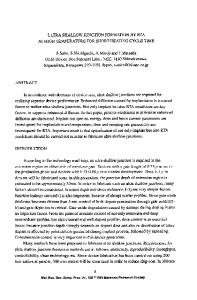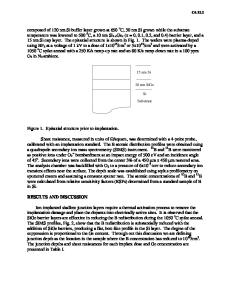Ultra Shallow Junction Formation by Cluster Ion Implantation
- PDF / 717,388 Bytes
- 6 Pages / 417.6 x 639 pts Page_size
- 58 Downloads / 376 Views
INTRODUCTION Shallow junction formation is a critical issue in deep sub-micron device fabrication. Low energy ion beams are urgently required to form ultra-shallow junction, and the beam currents
are greatly reduced due to space-charge effects. Much effort has been made to develop a low energy ion implanter. Cluster ion implantation is one of the most attractive alternative techniques[1-5] because it has two major advantages for the shallow junction formation. One advantage is the low energy effect of cluster ions. A cluster ion with a few tens of keV energy and a size of a hundred atoms, has a few hundreds of eV in each constituent atom. Therefore, it is quite easy to obtain the high current ion beams with low equivalent energy by using cluster ions. Shallow implantation can be realized with a high energy cluster ion beam. In addition, heavily doped layers can be obtained with low cluster ion dose because one cluster ion contains many dopant atoms. This helps to eliminate charge-induced gate oxide degradation which occurs during high dose ion implantation. The second advantage is the unique effect which results from local energy deposition and multiple collisions. Molecular dynamics calculation and experimental results show that the cluster size has a great effect on the defect formation. It has been reported that defects have a great influence on boron diffusion in Si[7-9]. Therefore, it should be possible to control boron diffusion which is an important issue in shallow junction formation. We have proposed to use decaborane(BoH14) as a cluster ion in order to fabricate shallow junctions. Decaborane is solid at room temperature and is safer than diborane(B2 H6). A decaborane molecule containing ten boron atoms, is equivalent to a boron cluster with the size of ten. We have been demonstrated that decaborane has a great capability to form shallow junction. When cluster ions with the size of N are implanted at N times larger energy, the same 17
Mat. Res. Soc. Symp. Proc. Vol. 532 ©1998 Materials Research Society
projected-range is expected. Therefore, the space-charge limited beam current (JN) follows the Langmuir-Child law;
jN
(N -
M =N{V2
M
)rM
(1)
where M and V are mass and acceleration voltage of the monomer ion, respectively. The number of atoms which one ion can transfer is N. Total particle current (J,0,,,) is given by Jo.l
=N.J,
oN2{VN .
(2)
This equation indicates that the space-charge limited beam current with cluster ion is N2 times larger than with monomer ion. Therefore, a two orders of magnitudes larger beam current will be realized when decaborane ions are used. Shallow junction formation and defect creation mechanism are discussed.
DECABORANE ION IMPLANTATION BF 2 ions are often used in boron implantation to obtain a shallow junction because of its heavy mass. Implanted boron atom distributions with 0.5 and 5 keV boron monomer ions(10 A.M.U.), 5 keV BF 2 ions(39 A.M.U.) and 5 keV ions(l19 A.M.U.) are depicted in Fig. 1. The ion dose was fixed at lxl0`4 ions/cm 2 for B and BF 2 ions. F
Data Loading...











